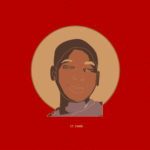The US Department of Arts and Culture (USDAC) may sound like a government agency, but unlike the National Endowment for the Arts, it can’t be eliminated with a pen stroke by the president. The USDAC is the nation’s only people-powered department—a grassroots action network inciting creativity and social imagination to shape a culture of empathy, equity, and belonging. Through national actions and local organizing, the USDAC engages everyone in weaving social fabric and strengthening communities through arts and culture, builds capacity and connective tissue among socially engaged artists and cultural organizers, generates momentum and public will for creative policies and programs rooted in culturally democratic values, and infuses social justice organizing with creativity and social imagination.
- Damon Davis | St. Tamir
- Damon Davis | St. John
- Damon Davis | St. Trayvon
- Damon Davis | St. Jessie
- Damon Davis | St. Michael
- Damon Davis | St. Aiyana
Damon Davis | #CanonizeThe Kids
Ten days after the 2016 presidential election, the people-powered US Department of Arts and Culture (USDAC), where I have the privilege of serving as chief policy wonk, launched Standing for Cultural Democracy, our ten-point policy and action platform. One by one, members of our national cabinet picked up a lightsaber and took to the stage at CULTURE/SHIFT 2016, the Regional Arts Commission of St. Louis and the USDAC’s first national convening on community arts. The venue was chosen in large part because the region has shown this nation so much about the importance of human and cultural rights and because it is home to so many dedicated and accomplished cultural organizers. Two hundred people cheered every point.
Platform Point 5, calling for investment in belonging and cultural citizenship, starts with this assertion: “Our chief cultural deficit is belonging.” It urges every public institution and private organization to adopt a “policy on belonging,” one that establishes standards of belonging to ensure that all public statements and policy and program decisions “assert, protect, and embody the primacy of belonging to the health of local culture and community . . . guaranteeing full belonging to each and every community and resident within our borders.”
The Policy on Belonging was proclaimed by Roberto Bedoya, cultural affairs manager for the city of Oakland and secretary of belonging on the national cabinet. He’d taken office just a few months before. Only weeks after the convening, Oakland’s December 2016 Ghost Ship fire ended the lives of thirty-six mostly young artists attending a gathering at a carelessly converted and poorly inspected warehouse. The USDAC responded with a piece in The Hill citing policies in our platform that could address the gentrification and displacement that have created Oakland’s disaster of belonging.
In that piece, we cited Platform Point 8. It calls for adoption of a “cultural impact study,” analogous to an environmental impact report, requiring assessment and amelioration of potential damage to cultural fabric before authorizing development or rezoning. It amazes us that while an endangered plant or insect can halt incursions into the built environment, there is no comparable standing in law or policy for human cultural rights and well-being.
How did Standing for Cultural Democracy: The USDAC’s Policy and Action Platform come to be? What impact can it have? I’ll tell the story from the perspective of the Policy on Belonging. It begins with the creation of the USDAC and the first iteration of its annual civic ritual, the 2015 People’s State of the Union.
Founding the People-Powered Department
The USDAC’s public launch took place in October 2013, with a press conference led by Norman Beckett, deputy secretary of arts and culture (a.k.a. Adam Horowitz, USDAC chief instigator, who first conceived of the people-powered department). The press conference was held at the annual convening of Imagining America, a national association of higher-education institutions and community groups involved in culture and community engagement. A few days later, right-wing pundit Glenn Beck denounced the department on his television program, sharing the USDAC’s Statement of Values as an example of a vast conspiracy by “well-funded radicals.” (As our budget was approximately zero at the time, we could only wish.)
That press conference was preceded by more than a year of research and planning with a handful of dedicated volunteers. We knew that if the USDAC were to succeed, we’d have to learn from past efforts at cultural organizing, and that had to start with interviewing artists and activists who’d been involved and could offer wisdom on how a twenty-first-century movement for cultural democracy might be built. Guided by their experience, we began scaffolding a volunteer-driven project that could engage people in both local and national organizing toward:
- welcoming each individual as a whole person;
- valuing each community’s heritage, contributions, and aspirations;
- promoting caring, reciprocity, and open communication across all lines of difference; and
- dismantling all barriers to love and justice.
- Our research made it remarkably clear what the USDAC’s core values should be.
Pleasure and purpose aligned
The USDAC is simultaneously an organizing project and a collaborative art project. As we like to say: “This is an act of collective imagination. Add yours.”
We play off a government frame with quasi-official trappings: national cabinet, cultural agents, regional envoys, and so on. Cabinet members choose their own titles. For example, Makani Themba, minister of revolutionary imagination; Lulani Arquette, catalyst for native creative potential; Judy Baca, minister of sites of public memory; Bob Holman, minister of poetry and language protection; and many such others. One might imagine the creativity of these titles would be a dead giveaway, but when I announced some years ago on Facebook that I had been appointed chief policy wonk, I got perhaps one-hundred congratulatory messages on receiving a public honor, most of them seeming entirely sincere.
The aha moments generated by the gap between expectation and reality have been a good organizing technique. People say, “I didn’t know the United States had a Department of Arts and Culture,” and once they read further and realize it isn’t an official arm of the public sector, it’s a quick hop to saying it should be. This is the macromanifestation of our own aha moment, the realization that cultural organizing—which uses arts-based methods to engage people, express their concerns and aspirations, and involve others who care about them—is a uniquely powerful mode precisely because it engages emotions as well as intellects, bodies, and spirits, offering simultaneous pleasure and purpose.
I think of art as sacred play, a practice that engages the whole person in contrast to the many conventional activities that invite only our fragmented selves. In a social context, art making and arts experience can cultivate much-needed empathy and social imagination—the capacity to put ourselves in the other’s place and feel something of the other’s truth, the capacity to envision a social order different from the one that powerful forces would like us to see as natural and inevitable. The threshold for participation in community cultural work is low. People come together because they want to share stories or music or paint and draw, for example, and the satisfaction of deploying those art forms with others who desire belonging, love, and justice leads to a heightened disposition to take part again.
When I look at conventional activism through a cultural lens, I often marvel at how people expect to nurture a sense of belonging by using cultural forms that telegraph exclusion. The public hearing where experts pronounce authoritatively and the rest of us line up to hold the mic for one or two minutes—this sort of thing is a cultural form for which few acquire a taste. If pleasure and purpose were the boundary conditions for activism, just imagine who would take part and how it would change.
“Our chief cultural deficit is belonging.”
Radical inclusion
Through our research, experience sent an unmistakable message: start out as you mean to go on. The historical map of arts and cultural organizations is dotted with groups that start as overwhelmingly white and later rush to remedy that bias with typically failed attempts to “diversify.” Often, the invitation reads as “come make us look good” rather than “let’s cocreate,” and often, the answer is, “No thanks.” Who wants to be used as a signifier rather than engaged as an equal partner?
We knew that from the start, multiple art forms, ages, races, ethnicities, faiths, orientations, regions, abilities, and more had to shape the work. For instance, I am forty years older than our chief instigator, Adam. Clearly, it would be a challenge to craft messages and structures that appealed to both our generations. But we had a strong hunch that if we succeeded, we’d also be able to scoop up the generations in between. This has proven correct: each of our actions since has drawn participation from students to elders. Indeed, one of the great successes of CULTURE/SHIFT 2016 was participants’ experiences of arriving so soon after the election, dazed with uncertainty, and easily crossing generational lines to console, support, and learn from each other.
When we put out our first call for cultural agents in 2014, more than one hundred individuals applied to serve as these volunteer local organizers, taking part in a learning cohort and organizing Imaginings—art-infused planning dialogues—in their own communities. We were surprised at the volume of response, but not its breadth. Each of the three cohorts of USDAC cultural agents has reflected our intentions, with a majority of women of color, with folks from both small towns and urban centers, and with many types of artists, educators, and organizers. There was a consistent disparity, to be sure: the vast majority of applicants were women, and no cohort achieved a proportionate number of men. (Though we can speculate about its origins, none of the popular theories—low compensation and job insecurity in progressive cultural arenas, an evidently greater proclivity to volunteer on the part of women—suggests a useful idea of how to resolve this imbalance. It’s one I encounter in every cultural convening I attend, in higher education, and in the majority of community-based organizations. Does the invitation to belong resound differently for men?)
People say, “I didn’t know the United States had a Department of Arts and Culture,” and once they realize it isn’t an official arm of the public sector, it’s a quick hop to saying it should be.”
To name the condition of belonging without barrier, we use the phrase “cultural citizenship,” always being careful to say one doesn’t have to be a citizen in the legal sense to belong. The concept of citizenship is contested, of course, because even using the word reminds people of all the ways immigrants and refugees have been stigmatized and excluded as “illegal” and unwanted. But we are not inclined to surrender contested words to those who use them as clubs to beat others into disbelonging: democracy, art, culture, and citizenship are fundamental human rights. In a condition of true cultural citizenship, everyone feels at home in their own communities. All heritages are honored for their contributions to the collective culture. Difference is embraced as a source of richness and wisdom. And wanting to know each other takes the place of fearing the other.
We live in a society in which the fullness of cultural citizenship is denied, even to most people who possess legal papers entitling them to vote and travel. How many Americans long to see their own communities of people portrayed on television as something other than criminals and degenerates? How many students are offered a version of history that consigns their own heritage to a footnote? How many are denied the right to culture as expressed through fundamental acts of expression and association: walking or driving while black, dancing together in a nightclub, visiting with friends while waiting for public transit.
Multiple levels of engagement and impact for individuals and groups
Gazing out at the cultural landscape, we saw many groups doing powerful local or regional work, and a few organizing on a national level. But generally, the two didn’t connect up. As with other forms of progressive organizing, within a national frame, the scope of individual participation was often distant and superficial: sign this petition, click this link, read this message letting you know if a bill passed, and donate money.
The challenge of a movement for cultural democracy is that it is all about culture, a collective creation most fully expressed in all of life’s textures, in person. Culture describes the ways that human beings form communities, communicate, enter into relationships, and create the crucible in which identities and meanings are forged. You can’t do that by clicking a link. Therefore, we knew we would need to adopt an approach that:
- engages everyone in weaving social fabric and strengthening communities through arts and culture;
- builds capacity and connective tissue among socially engaged artists and
cultural organizers; - generates momentum and public will for creative policies and programs rooted in USDAC values; and
- infuses social justice organizing with creativity and social imagination.
Our approach had to be prefigurative and realistic, demonstrating to the greatest extent possible the quality of reciprocity and mutuality that so many people desire in the world and that we are working to bring about. We could not adopt modes of interaction that repeated the gross or subtle injuries of the dominant system: treating people like categories instead of individuals, like numbers rather than living beings; speaking for people rather than together creating channels and invitations for all to speak their own words in their own voices; treating challenges that affect individuals and groups differentially, as if they were separate from each other or subsidiary to whatever may be deemed the most important challenges to freedom and justice; or adjusting to an absurd system and insisting that everyone play by its rules.
It became clear that just as we needed a network of local organizers and communities to support and learn with each other, we needed a national cabinet rooted in lived knowledge (as opposed to credentialed expertise that may dismiss the value of ground-level experience in favor of research at a distance, about rather than of) to act on local wisdom. Cabinet members could hear what those communities held dear or felt to be threatened in these times, and help translate that knowledge into national ideas, both policy and action interventions. We think of our model as a perpetual circuit: local work generates information that informs national deliberations, resulting in policy and action proposals that can be tested at the local level, yielding experience that refines the national perspective, improving community work—and so on.
People’s State of the Union
The USDAC’s first National Action was founded on a principle that incorporates belonging and infuses all our work: democracy is a conversation, not a monologue. The first People’s State of the Union (PSOTU) in 2015 set the pattern. In November of each year, we invite people across the United States to hold Story Circles during a ten-day period beginning in late January, sharing stories that reveal something of the state of our union as they experience it. Their stories are uploaded to Story Portal, where anyone may peruse and use them. Then a group of invited poets, inspired by the stories, composes the collective Poetic Address to the Nation, which is performed, live-streamed, and published. The 2017 Poetic Address was presented on March 11 at the Yerba Buena Center for the Arts in San Francisco, demonstrating the second principle shaping the PSOTU, that all our lives are the material of art, and all our experience is worthy of being uplifted into poetry.
A Story Circle is a small group of individuals sitting in a circle, sharing stories—usually from their own experience or imagination—focusing on a common theme. As each person in turn shares a story, a richer and more complex story emerges. By the end, people see both real differences and things their stories have in common. A Story Circle is a journey into its theme, with multiple dimensions, twists, and turns. Theater makers, such as Roadside Theater and John O’Neal, have been central in developing the practice for use in creating original performance and community telling and listening projects. For instance, both companies typically use their own method of story circles to elicit stories that yield incident and dialogue for use in devised theater.
It could be said that sitting in a circle sharing stories is one of the world’s oldest forms of cultural practice. It’s easy to imagine ancient ancestors passing a tale around a campfire. We’ve made Story Circle into a proper noun to acknowledge the specific techniques the USDAC has adapted for our purposes.
When we invite people to come together to share stories, certain concerns are paramount. Unstructured dialogue on contentious issues, such as the state of the union, tends to break down quickly into a contest of opinion. To avoid this, we are careful to specify that stories come from direct experience, with a beginning, middle, and end. The difference this makes is remarkable: when I tell a story that starts out “One day, I was walking along and met a woman . . . ,” there are no grounds to contest my account. I am the world’s foremost expert on my own experience, and the Story Circle framework embodies that honoring of each person’s truth.
We offer a free toolkit and training to anyone who wishes to take part. Each person in a Story Circle has equal time—generally three minutes or less—to share a story in response to a prompt. Prompts are generous in conception, questions that everyone is equally free and able to entertain, but once offered, they are not enforced: any story a teller chooses is the right story to tell. For PSOTU 2017, these were the prompts:
- Share a story about something you have experienced that gave you insight into the state of our union.
- Share a story about a time you felt a sense of belonging—or the opposite—to this nation.
- Share a story about a time you broke through a barrier to connect with someone different from yourself or with whom you disagreed.
Circles are small, optimally around eight people including a facilitator and a scribe if the stories are to be captured for future use (with tellers’ consent, of course). They are emphatically not performances. We urge people to focus on deep listening, not on crafting one’s own story, assuring everyone that a story will arise when their turn comes. Participants are asked to observe a few simple guidelines: total attention to each teller; no contradiction, cross talk, or comment—even positive—that pulls attention from the teller; a moment of silence between stories to allow them to settle. After everyone who wishes has shared (usually once or twice around the circle), the group reflects on what is revealed by the body of stories: What touched them? What stood out as notable differences or common threads? What might be learned from the aggregate of stories shared?
By now I’ve been privileged to hear hundreds of stories in dozens of Story Circles. The practice astonishes me with its simplicity and power to embody real belonging. Equalizing time and attention means that the middle-school principal and the sixth grader sitting in the next chair have a rare experience of reciprocity. The principal may start out by thinking, “Oh no, now I have to listen to this kid!” while the sixth grader may come in thinking, “No one told me the principal would be here!” But inevitably, in the telling—in the polite insistence that the principal heed the time limit, in each person’s surprise at what a deep and revealing story the other shared, in the sixth grader’s delight at finally getting total attention, warm and respectful, from a group of adults—those feelings change.
The metastatement of the Story Circle and the PSOTU is that everyone deserves the experience of belonging without barrier. Perhaps it is that glimpse of true belonging afforded by the Story Circles that authorizes people to share so many stories of belonging and what Roberto Bedoya has called “disbelonging.” Consider this 2017 story uploaded by Shelle from Albuquerque, New Mexico:
The question of belonging hit me very hard today. Generally, I have always felt like I belong to many groups—belong as an artist, belong as an educated white woman, belong as a bilingual New Mexican. My children are biracial, so I feel like I belong in the conversation about black identity and racial equity—it concerns me every day. I am married to a Hispanic man, so I belong to his family and culture, and I feel that deeply. But now, today and lately, I feel that sometimes I belong to a group, and other times I don’t belong to any of those groups.
I think of my biracial boys, as youngsters, who are now teenagers. They say what I said to my parents, like, “You don’t understand what I am going through.” And when my boys were very young, I realized this would be true for my boys in a way that was much deeper than it was when I said it to my parents. And during this election cycle, I carry this sense of being sure where I belong.
The morning after the election, my husband and I were getting ready to board an early morning flight to Chicago (and I was sad and fearful to leave my black teenage boys that day). My seventeen-year-old son got up after a long night of election results (he was checking on his phone throughout the night), and he said to all of us (my sisters-in-law were also there), “Let’s all share our biggest fears this morning after this election!” He said he’d go first. “I’m most afraid of national stop and frisk.”
No one said anything for a full minute. What could we say? And I was afraid, too—of that (and of so many other things) and that my beautiful young man/son was afraid. He grew up with a black president and sense of empowerment—and on the verge of his adulthood, it all feels and sounds completely different. And I don’t know how to hold those two realities in my mind—my elementary school biracial boys watching the inauguration of the first biracial president and my young adult black sons living in a rise of racism and hateful, public rhetoric.
Analyzing the yield of all three PSOTU iterations to date, so many different stories speaking of the same fears and desires—that led us to the opening sentence of Platform Point 5: “Our chief cultural deficit is belonging.”
The Policy on Belonging
When we set out to base policy and action proposals on the stories people across the country had shared with the USDAC, we understood that the USDAC’s policy initiatives had to break with the conventional model. They had to focus on policies and actions that promoted universal social goods instead of singling out certain people and organizations for special support.
In the global policy arena, cultural policy has significant scope, encompassing telecommunications, education, training, preservation, regulation, and research, as well as funding—a whole universe of cultural aspects reflecting the inclusive nature of culture as a concept. Indeed, in the broadest sense, it’s accurate to say that everything not given as part of nature belongs to the category of culture. Consider the way this understanding is encoded in the cultural programs of the United Nations Educational, Scientific, and Cultural Organization (UNESCO), for instance, the largest international agency with cultural policy-making responsibilities. UNESCO Initiatives focus on diversity, sustainable development, world heritage, and much, much more. The commercial cultural industries, such as broadcasting, publishing, film, and television, are part of the ecology just as much as museums, dance companies, orchestras, and community arts centers.
In contrast, here in the United States, there’s been a determined effort to sequester the nonprofit arts from the vastly larger and more influential commercial sector. Almost always, when advocates talk about this policy arena, they mean it very narrowly, as arts not culture: grants for artists and nonprofit organizations, arts-in-schools programs, and not much more.
There are complicated reasons why this view is promoted. To mention just one example, when the National Endowment for the Arts (NEA) was established in the midsixties, with a Cold War chill in the air, the major institutions and funders advocating for a federal agency were frightened that they’d be defeated if legislators thought they were leading to some form of state art. They were careful to position federal funding as a junior partner to private philanthropy and box-office income, to always assert that the private sector should lead.
As I write, the present occupant of the White House has called for elimination of the National Endowments for the Arts and Humanities and the Corporation for Public Broadcasting, agencies targeted by Republicans since Ronald Reagan became president. As always, threats to eliminate funding that amounts to a fraction of 1 percent of federal discretionary spending are framed as cost cutting. But since they actually have no fiscal impact, we must understand them as symbolic gestures, garnering headlines and distracting the electorate from noticing that we have spent more than three annual NEA budgets a day on war since 2001, or that new tax breaks for the wealthiest will more than cancel the minuscule savings proposed.1)More history and data sources are contained in “Symbolic Gesture Comes Out of Retirement,” the USDAC blog post we published on January 20, 2017, when elimination of the federal cultural agencies was first threatened.
We knew that the USDAC’s policy initiatives had to be framed in this larger context, rather than follow the failed conventional approach of special pleading by direct beneficiaries for their own budgets. Attempting to say something beyond “Support us; we’re wonderful,” most past arts advocacy has been couched in weak arguments for art as an economic stimulus. Advocates say those who buy theater tickets also contribute to the economy by buying parking and meals when they attend performances, but of course, going to a football game has exactly the same impact. Although this approach is a failure—in absolute dollars, the NEA 2016 budget hasn’t changed since 1980, but its real value has declined by more than half—advocates loyally pursue it.
The impact on belonging and cultural citizenship has been deeply distressing. When public policy follows private-sector proclivities, the beneficiaries tilt toward those who offer reflected glory to wealthy donors. Elite and largely white organizations—the red-carpet opera companies, ballet companies, major museums, and symphony orchestras—continue to receive disproportionate public and private funding, paying lip service to diversity but showing no inclination to surrender privilege.
Instead of following the conventional arts funding pattern of plucking the best fruits, we have chosen to water the roots, advocating initiatives that benefit everyone, including artists along with many others. And the most important root to nurture is belonging.
In Standing for Cultural Democracy, we quoted Roberto Bedoya’s (undated) essay for Arts in A Changing America:
The state of our society is under a great deal of stress triggered by the continuing recession and its challenges to our economy, the growing plutocracy’s abuse of our civil rights, the Cultural War 2.0 battles over women’s rights to control their own bodies, the rights of Union workers, the rights of Mexican American students to study Latino literature, the right to be free of racial profiling, the right of gays and lesbians to marry their loved one, immigrant rights . . . you can add your own example of the politics of dis-belonging at work in civil society.
We added this call to action:
To sustain a functioning civil society that even aspires to full cultural citizenship, the challenge of belonging and dis-belonging must be acknowledged and addressed. There is a long way to go to achieve even the first step here, awareness. Has any city or state adopted a policy on belonging, let alone invested in new initiatives to cultivate a universal sense of belonging?
To cultivate belonging, we proposed five actions, excerpted below:
- Adopt a policy on belonging for public institutions, such as municipal or state governments, and private organizations, such as community centers. Adopting such a policy is the foundation for any action taken to extend and deepen belonging.
- Support long-term artists’ residencies at the neighborhood level by artists with experiences and skills in community cultural development to assess the state of belonging in their communities and creatively conceive and test ways to strengthen it. This includes recognizing and supporting the contributions of local artists and culture-bearers, as well as preparing and supporting allied outside artists to enter communities, listen deeply without preconception, and respond to specific needs and opportunities in each place.
- Support community-based centers that engage people directly in art making and art experiences as laboratories for belonging, offering ideas and experiences that can be replicated or adapted widely as sites of belonging that anchor a community, integral to strategies to resist displacement, preserving and strengthening existing social fabric.
- Support creative use of underused spaces such as schools, houses of worship, and public plazas, reimagining the untapped commonwealth these spaces represent, making maximum use of them for learning, making art, public performances, and other gatherings.
- Repurpose disused spaces such as vacant lots and empty storefronts as pop-up community cultural centers, engaging people in art making and art experiences as they go about their day. A key consideration is to anchor these spaces in existing community culture so that they don’t invite gentrification and displacement.
Taken together, these actions express our understanding of the challenge of creating true belonging: that like rights, policies are meaningless without sufficient resources to safeguard, express, and extend them. To declare that “everyone belongs” but fail to encode that principle in enforceable public decisions and actions adds up to a meaningless gesture that actually repeats the injury it ostensibly addresses.
If we assess the US cultural landscape, we see well-provisioned, prosperous communities side by side with neighborhoods that are home to immigrants or low-income communities, often communities of color, where underused public space is guarded by high fences rather than made available for community use. We see largely white and well-off neighborhoods, where city planners would never consider rezoning in ways that disrupt social fabric, side by side with less privileged neighborhoods, where planning decisions are undertaken without the slightest consideration of cultural rights, razing sites of public memory and rezoning to attract new tenants to displace those whose contributions created rich community.
The model Policy on Belonging we have offered for public and private adoption requires “all public statements and actions to assert, protect, and embody the primacy of belonging to the health of local culture and community, and mandat[es] that all public actions and statements reflect the letter and spirit of this resolution, guaranteeing full belonging to each and every community and resident within our borders . . .”
It begins by stipulating the past actions and current conditions that call for such a policy, goes on to define the relevant terms and conditions, and concludes with a participatory review process resulting in a decision to “reject the proposed action for negative impact on the right to culture, belonging, and/or full cultural citizenship; recommend one or more of the alternatives set out in the request for review or a superior alternative emerging from the review process, indicating approval if the recommended alternative is substituted for the original proposed action; describe mitigating action necessary for resubmission of the proposed action for approval; or approve the action as proposed.”
In this moment, with othering being decreed via executive order, belonging is more imperiled than ever. In January, when the travel ban on seven Muslim-majority countries was announced, the USDAC circulated a Pledge on Cultural Rights and the Muslim Ban:
The first step in a top-down campaign to obliterate cultural rights in the United States has been taken. We are called to stand together in response.
On January 27, 2017, a presidential executive order was issued blocking refugees and restricting immigration from Muslim countries. Protest has been immediate and massive.
History teaches us that authoritarian regimes start their mission of domination with the right to culture: limiting cultural communities’ freedom of movement and practice, condemning or restricting press freedom, condemning or restricting artistic expression, and denying the fullness of belonging to all but a privileged few. Artists and creative activists have key roles to play.
The response was rapid and enthusiastic.
The message of defending and extending cultural rights and belonging has been carried through all our 2017 initiatives to date, both in the PSTOU and in the #RevolutionOfValues, the day of creative action on April 4, 2017, which is the fiftieth anniversary of Dr. Martin Luther King Jr.’s groundbreaking speech, “Beyond Vietnam: A Time to Break Silence.”
To declare that “everyone belongs” but fail to encode that principle in enforceable public decisions and actions … repeats the injury it ostensibly addresses.
This spring also marks the launch of a concentrated USDAC campaign to adopt the Policy on Belonging, inviting all those who signed the pledge to do more than declare their commitment. In an alternate universe, such a campaign might go straight to Washington, focusing on adoption of a national policy. But current reality is that belonging must start with the smallest units of social organization and build up. We can’t expect belonging to take shape out there, to be granted courtesy of some distant authority. But even in such perilous times, community organizations and institutions and agencies of local government remain more accessible and, therefore, potentially more responsive.
We want to extend this invitation to all readers of Othering & Belonging. Spend a moment exercising your social imagination: How would your community change if a policy on belonging were adopted and implemented by the city council, the school board, the local neighborhood center? Everything created must first be imagined. The Policy on Belonging begins as an act of collective imagination. Please add yours.
Access the Policy on Belonging to download the toolkit.
References
| 1. | ↑ | More history and data sources are contained in “Symbolic Gesture Comes Out of Retirement,” the USDAC blog post we published on January 20, 2017, when elimination of the federal cultural agencies was first threatened. |









